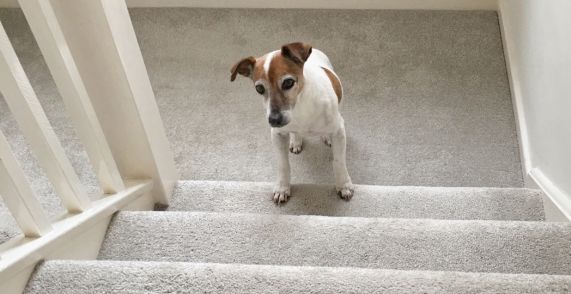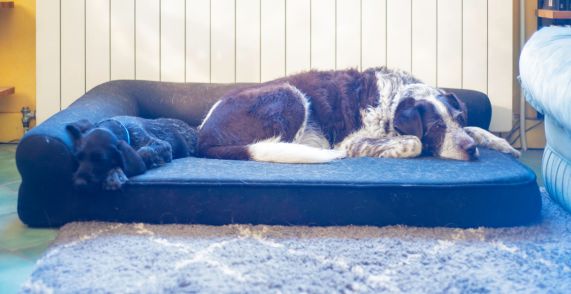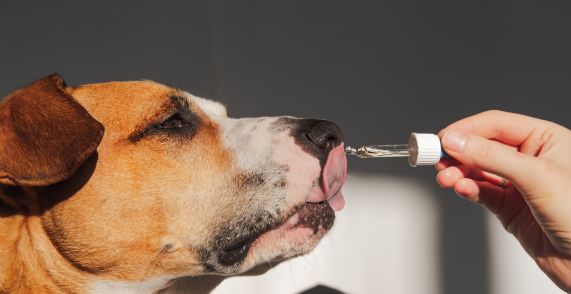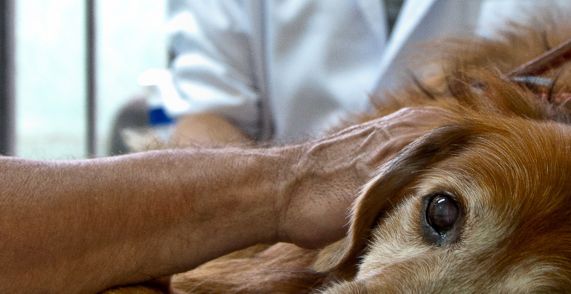Imagine if you were out on your regular morning jog, a simple task that you’ve been doing every day for years.
But this time running seems monumentally painful, not because of an injury from a fall or an accident, but simply because of the wear and tear on your body over time.
Now imagine seeing your furry friend suffering similar discomfort during their usual stroll around the block or playtime with a ball in the park. Excruciating, isn’t it?
This is what hip dysplasia feels like for dogs – an ongoing painful struggle to do everyday activities they love.
Quick Facts
- Approximately 20% of all dogs will develop hip dysplasia at some point in their lives.
- The most common breeds affected are German Shepherds, Labradors, Rottweilers, Golden Retrievers and Great Danes.
- Overweight dogs are more likely to develop hip dysplasia, with an estimated 60% of overweight dogs developing the condition.
- The average age of diagnosis for hip dysplasia is 5 years old.
- The most common symptom is lameness in the hind legs.
- Other symptoms include difficulty rising, reluctance to exercise, and a “bunny hopping” gait.
And if your four-legged friend is going through such hardships, don’t worry! There’s good news in sight: With various home treatments available today, you can bring back the spring in their step.
This blog post will dive into some of these best options to provide relief to dogs with hip dysplasia right in the comfort of your home.
Some effective home treatments for dogs with hip dysplasia include controlling their weight, modifying their diet to include joint-supportive supplements and anti-inflammatory foods, providing an orthopedic dog bed made from memory foam, and engaging in moderate exercise on soft surfaces.
Physical therapy and natural supplements like glucosamine and chondroitin have also been shown to alleviate joint damage, maintain joint fluid thickness, and boost cartilage repair in dogs. However, it is important to consult with a veterinarian before starting any new treatment regime.
Home Treatment for Hip Dysplasia in Dogs
Hip dysplasia is a painful joint disease that affects many dogs, but there are effective home treatments that pet owners can implement to reduce pain and discomfort.
Early diagnosis is crucial, as it allows for treatment to begin before the condition becomes too severe.
If you suspect your dog has hip dysplasia, it is important to see a veterinarian so they can perform an examination and recommend the best course of treatment.
One home treatment involves modifying their living environment.

Dogs with hip dysplasia may experience difficulty moving around or climbing up stairs, so providing them with ramps or inclines can make it easier for them to get around.
Additionally, placing rubber mats or carpeting on slippery surfaces can improve traction and reduce the risk of injury.
Another essential part of home treatment is creating a comfortable resting area. Orthopedic dog beds made from memory foam provide adequate support and cushioning while distributing pressure evenly across the body, helping to alleviate pain and promote better rest.
This type of bed reduces pressure on the joints and improves overall mobility.

Similarly, think of your dog’s orthopedic bed like a high-quality mattress for people. Just like how a good mattress supports our bodies while we sleep, an orthopedic bed helps keep our furry friends more comfortable and pain-free when they are not moving around as much.
Another way to treat the condition at home is through light exercise and physical therapy. Low-impact exercises such as walking on soft surfaces or swimming can help control weight gain and improve muscle development while minimizing joint strain. Physical therapy can also improve range of motion and mobility through directed exercises.
Ultimately, creating a comfortable living environment along with controlled exercise and physical therapy can aid in reducing hip dysplasia symptoms. However, it is important to also focus on their diet and supplement intake to alleviate the condition
Mobility Exercises for Better Movement
In addition to creating a comfortable living environment and implementing controlled exercise routines, mobility exercises can help improve your dog’s movement and overall joint health. These types of exercises increase joint flexibility, strength, and range of motion, improving their ability to perform daily activities with ease.

A simple exercise for dogs involves short walks on even surfaces. Regular short walks throughout the day will help prevent over-exertion while also aiding in joint movement. You can also try gentle stretches such as leg lifts, walking up stairs or a slight incline, or walking over small obstacles like cones.
Swimming is another effective low-impact exercise that promotes range of motion and muscle development without straining the joints. The water buoyancy supports your dog’s weight while providing the resistance needed for a full-body workout.
While beginning mobility exercises, many pet owners face a difficult task – determining how much activity for their dog is too much. Overdoing it could lead to further damage or increased pain levels. Pet owners should consult with their veterinarian when implementing an exercise routine that best suits their dog’s needs.

With dedication and persistence in implementing in-home treatments and mobility exercises for your dog, these changes can significantly improve their quality of life.
Always follow veterinarian guidelines on proper HIPAA schedule vet visits to determine if treatment options need updating or changing.
Effective Pain Management Techniques
Hip dysplasia can cause severe pain and discomfort in dogs, impacting their quality of life and overall well-being.
Fortunately, there are a number of effective pain management techniques that pet owners can implement at home to alleviate their furry friend’s discomfort.
One of the most prevalent pain management techniques is the use of non-steroidal anti-inflammatory drugs (NSAIDs) prescribed by veterinarians.
Although this medication can effectively reduce inflammation and pain in dogs, it comes with some potential side effects such as stomach ulcers, kidney and liver disease, and gastrointestinal bleeding.
That being said, owners may opt for natural alternatives to NSAIDs such as herbal remedies like turmeric, ginger or willow bark.
These natural remedies have been shown to have similar anti-inflammatory properties without the adverse side effects of conventional medication.
However, before administering any form of treatment, it’s essential to consult a veterinarian who’ll advise on dosage and evaluate possible interactions with the dog’s current medications.
Another popular choice among pet owners is CBD oil extracted from marijuana or hemp plants.
While clinical evidence to alleviate joint problems in dogs is limited, anecdotally many people reported beneficial outcomes from using CBD infused products on pets.
Despite positive experiences from many pet owners, research on long-term effects and proper dosages remains limited.
Possibly overlooked but certainly worth trying, heat therapies are a popular option due to their simplicity yet effectiveness in managing chronic arthritis pain.
Heat therapy is ideal for dogs with hip dysplasia because it increases blood flow, eases stiffness in arthritic joints and relaxes sore muscles.

Consider placing a hot water bottle on affected joints or purchasing specialized heated pet pads for more comfort.
The ultimate goal when dealing with hip dysplasia is ensuring their continued mobility, to this end pain relief is paramount. The next section discusses how adjusting a dog’s diet will provide further support.
- A 2020 study showed that maintaining a healthy weight can reduce the risk of hip dysplasia in dogs by up to 60%.
- According to a report by the American Veterinary Medical Association (AVMA), non-surgical treatments such as physical therapy and use of anti-inflammatory herbs can help manage pain in up to 80% of dogs with mild to moderate hip dysplasia.
- A survey conducted by The Journal of Small Animal Practice found that around 70% of dog owners reported an improvement in their pet’s mobility after using canine-specific orthopedic beds.
Diet and Supplements for Joint Health
A healthy diet comprising adequate amounts of vitamins, minerals, protein, and carbohydrates is essential for promoting joint health in dogs. In addition to maintaining their weight loss regimen, several supplements have been shown to help relieve the pain and even reduce its progression.
Vitamin C plays an essential role in collagen synthesis and is vital for cartilage health. Studies show that increasing vitamin C consumption helped decrease bone thinning in dogs and reduce susceptibility to fractures.
Sources include blueberries, broccoli, cantaloupe, oranges, strawberries and sweet potatoes – before giving any supplement over-the-counter or prescribed kindly check-in with the vet.
Glucosamine and chondroitin sulfate are popular supplements widely used in treating hip dysplasia in dogs.
Both substances are natural compounds found in the body where they play a major role in lubricating joints, reducing inflammation and supporting cartilage repair.
Scientific studies have proven their efficacy in managing hip dysplasia symptoms as well as overall joint problems.

Other common nutritional options include omega-3 fatty acids supplements which can be derived from fish oils or flaxseeds oil.
Not only do these supplements help reduce inflammation, but they also promote optimal skin health while helping joints heal after an injury.
Similarly unproven as CBD oil treatments, hempseed oil might require more clinical evidence to support its effects on joint health when given internally.
Importantly, like human beings experiencing a health challenge; avoiding processed foods where possible and consuming whole foods will make all the difference.
Whole grains like brown rice are good sources of magnesium which helps regulate nerve function and calcium absorption.
While diet control and supplements offer relief to dogs with joint issues, alternative therapies can be added to the toolbox of pet owners helping to make their furry friend’s life less painful.
Importance of Weight Management
Weight management is a crucial aspect of treating the condition. Being overweight puts more pressure on their joints, leading to pain, discomfort, and inflammation.
Excess weight also hinders mobility, making it difficult for dogs with dysplasia to move around freely. Therefore, controlling your dog’s weight should be a top priority when treating this joint disease.
One way to control your dog’s weight is by feeding them a balanced diet that meets their nutritional requirements but doesn’t exceed their calorie needs.

Feed your furry friend smaller portions frequently throughout the day instead of a large meal once or twice a day. You can also incorporate low-calorie treats into their diet and avoid giving them table scraps or human food.
A study conducted by the Morris Animal Foundation and Royal Canin revealed that dogs who were fed 25% less than the recommended amount had significantly reduced signs of arthritis and hip dysplasia within just two months.
This highlights the importance of maintaining an ideal body weight in managing joint diseases in dogs.
Some pet owners might argue that they don’t have control over their dog’s weight due to genetic predispositions or other medical conditions.
However, it is still essential to manage your dog’s weight as best as you can to reduce the strain on their already compromised joints.
Now that we understand why weight management is crucial let’s explore key supplements for joint support that can help manage hip dysplasia in dogs.
Key Supplements for Joint Support
Feeding joint supportive supplements can help prevent progression and alleviate some of the symptoms associated with the disease. Here are some key supplements that you can add to your dog’s diet for joint support:
Glucosamine and chondroitin are popular supplements used for joint support in both humans and dogs. These supplements help maintain joint fluid thickness, boost cartilage repair, and provide pain relief.
When combined with good nutrition and exercise, they can help slow the progression of hip dysplasia.
Just like how oil keeps a car’s engine running smoothly, glucosamine and chondroitin keep a dog’s joints functioning correctly by improving lubrication in between each joint.
Omega-3 fatty acids found in fish oil can help reduce inflammation in the joints, thus alleviating pain and discomfort. Salmon oil is an excellent source of omega-3 fatty acids and is easy to incorporate into your dog’s diet.
A study conducted by the College of Veterinary Medicine at Kansas State University revealed that green-lipped mussel extract helped reduce arthritic symptoms in dogs with hip dysplasia.
This supplement has anti-inflammatory properties that help alleviate joint pain and stiffness.
Another supplement that has gained popularity for its joint support benefits is turmeric. Curcumin is the active ingredient present in turmeric, which has potent anti-inflammatory effects.
Adding a small amount of turmeric powder to your dog’s food can provide them with significant benefits.
There might be some concerns regarding the safety and efficacy of joint supplements for dogs. However, numerous studies have shown that when used appropriately, these supplements are safe and effective in managing joint diseases.
The right combination of home treatments can help effectively manage and improve your dog’s overall quality of life.
Alternative Therapies and Natural Treatments
Aside from traditional medications, there are many natural treatments that can help. These alternative therapies can be used alone or in combination with other treatments for better outcomes.
One such therapy is acupuncture, a practice that involves the insertion of small needles into specific points on the body to alleviate pain and improve overall health.
Acupuncture has been known to increase endorphin levels, reduce inflammation, and promote healing.
In fact, research shows that its effectiveness in treating hip dysplasia may even surpass that of drug interventions.
Another option is chiropractic care, which involves adjustments to the spine and joints to improve alignment and movement.
By addressing misalignment caused by hip dysplasia, chiropractic care can significantly reduce pain and discomfort.
Its benefits also extend beyond the physical; many pet owners report improvements in mood and behavior following sessions.

Some practitioners may also recommend homeopathy, a form of alternative medicine that uses natural substances to stimulate the body’s own healing process.
While there are limited studies on its efficacy in treating hip dysplasia specifically, proponents claim that it can help reduce inflammation and support joint health.
Utilizing Heat Therapy and Massage
Heat therapy and massage are two simple yet effective methods of treatment.
Applying heat packs or warm towels to affected areas can help increase blood flow and reduce stiffness. You can make your own heat pack by filling a sock with uncooked rice or beans and microwaving it for a few minutes until warm.
Just be sure to avoid using anything too hot that could burn your dog’s skin.
Think of it like a hot shower after a long workout – soothing warmth can work wonders for sore joints!
Massage can also be extremely beneficial. By manipulating the muscles and tissues around the joints, you can help improve circulation, increase flexibility, and reduce pain.
For an added bonus, many dogs find massage to be a calming and enjoyable experience.
While alternative therapies and natural treatments are worth exploring, it’s important to note that their efficacy may vary depending on your dog’s individual case.
They should never replace treatment recommended by your veterinarian. With proper care and management, however, you can help your furry friend live a happier, healthier life.
Adapting Your Home for a Dog with Hip Dysplasia
When dealing with this painful condition, it is important to ensure that your home is a safe and comfortable space for your furry friend.
As the disease progresses, mobility becomes an issue, and your dog may have difficulty moving around the house. In this section, we’ll take a look at how you can adapt your home to suit the needs of your dog.
One of the first things you should consider is installing ramps or stairs to help your dog move around more easily.
This can be especially helpful if you live in a multi-story home or have furniture that your dog likes to climb onto. With ramps or stairs, your dog won’t have to put as much pressure on their hips and can move around more comfortably.
Another important factor to consider is flooring. Hardwood or tile floors can be slippery, which can cause discomfort and even injuries for dogs with hip problems. Consider adding rugs or mats to provide traction and make it easier for your dog to walk around without slipping.

Some people believe that raised feeding bowls can help by reducing the amount of strain on their hips. However, there is conflicting evidence on whether this is actually beneficial.
While some studies have shown that raised feeding bowls can reduce strain on a dog’s neck and spine, others have found no significant difference in joint health between dogs who ate from raised versus non-raised bowls.
Think of it like this: just because something works for one dog doesn’t necessarily mean it will work for another. The best approach is to monitor your individual dog’s reaction to raised bowls and judge what’s best based on their reactions.
When it comes to providing comfort for your dog, you should consider investing in an orthopedic bed. Orthopedic beds are made from memory foam and can provide support for your dog’s joints, reducing any discomfort or pain associated with hip &/or joint problems.
Finally, make sure that your home is free of hazards that could cause injury to your dog. For example, remove any obstacles that could cause your dog to trip or fall. Keep sharp edges covered or soft, and make sure electrical cords are out of reach.
By adapting your home to suit the needs of a dog with joint issues, you can help them move around more comfortably and reduce their pain levels.
It’s essential to work with a vet who can advise on the best treatments , but by making simple changes to your home environment, you can create a safe and comfortable space for your furry friend.
Frequently Asked Questions:
Q. How can I prevent my dog from developing hip dysplasia?
Although it’s a common and painful condition in dogs, it can be prevented with proper care and nutrition.
The first step in prevention is to feed your dog a balanced, high-quality diet. Look for a food that is specifically formulated for large breed dogs, as they are more prone to these types of joint issues. Make sure the food contains plenty of calcium and phosphorus, as these minerals are important for healthy bones and joints.
Q. What should I do if I notice my dog’s condition worsening after starting these home treatments?
A. If you notice your dog’s condition worsening after starting home treatments, it is important to take immediate action. The first step is to contact your veterinarian and provide them with detailed information about the home treatments you have been giving your dog, as well as any changes in their behavior or health. Your veterinarian will be able to assess the situation and provide you with advice on how to proceed.
Q. Who should I consult about home treatment options for my dog?
A. It’s important to consult with a qualified veterinarian. Your vet will be able to assess your pet’s individual needs and recommend the best course of action for their specific condition.
Your vet will be able to provide you with information on the types of home treatments that are available for your pet, as well as any potential risks or side effects associated with them.
Q. Who is qualified to perform hip dysplasia surgery?
A. This type of surgery is a complex procedure that requires a highly skilled and experienced surgeon. The most qualified surgeons are orthopedic surgeons who specialize in pediatric orthopedics. These surgeons have specialized training in the diagnosis and treatment of hip dysplasia, including the surgical correction of the condition.
If your veterinarian recommends that you stop the home treatments, it is important to follow their advice.
Elise is the owner of HMD. She has spent her whole life around dogs starting from when she was growing up on her parents farm. She is a prolific writer and blogger who passionately writes about her love for her canine friends.

